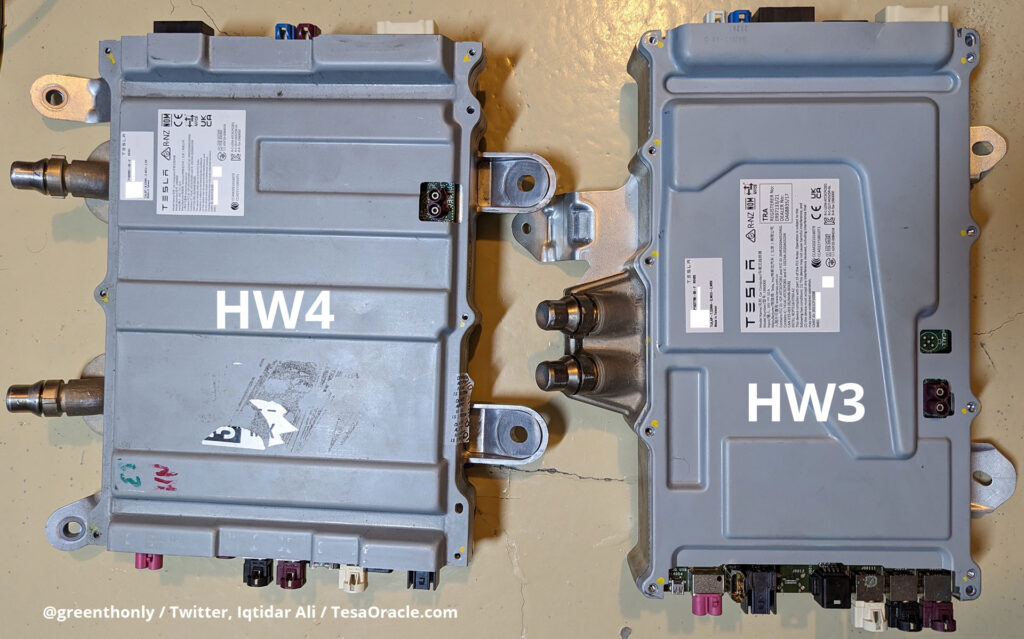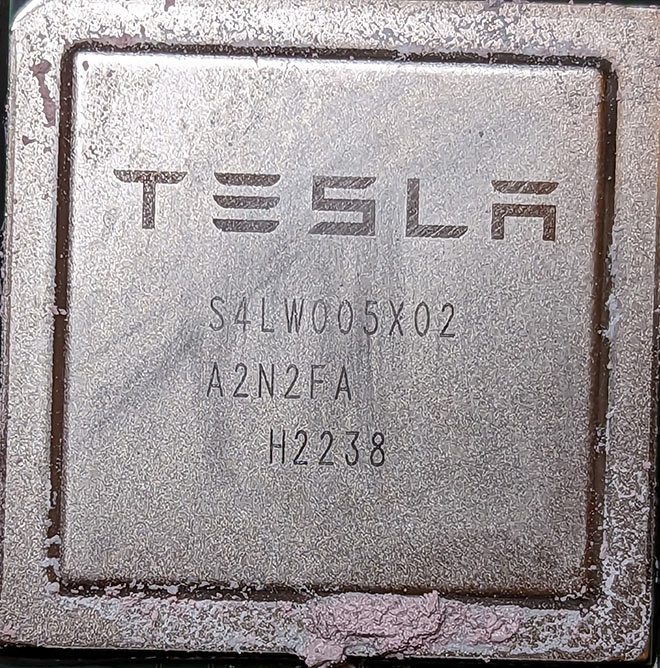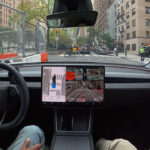Tesla Autopilot is of course a combination of both hardware and software like any computer in the world. Recently, the next iteration of the hardware part has been a hot topic of debate inside the Tesla Community of owners, enthusiasts, and investors — aka HW4.
Tesla revealed the previous generation of the world’s most advanced self-driving supercomputer at the company’s Autonomy Day 2019. At the time, Elon Musk referred to it as FSD Computer but it gained popularity with the name of Hardware 3.0 or HW3 in short.
The improved and scaled-up HW4 computer started shipping in Tesla cars in January of 2023. The new HW4 computer is marginally better than its HW3 predecessor and both differ in form factors as well.
Tesla cars produced with HW3 had 8 external cameras along with 12 ultrasonic sensors and a forward radar (see diagram below). Tesla removed radars from its vehicles in favor of the Tesla Autopilot AI Vision in 2021.

Although Tesla’s next HW4 computer was expected to be launched sometime in 2021, the global chip shortage and supply chain issues got in the way of this timeline. It was only Q3 of 2022 when strong rumors of the launch of HW4 started to pop up on social media, especially Twitter.
A Tesla ethical hacker with the alias @greenthonly posted images of the Tesla HW4 computer system-on-chip (SoC) he had acquired from a newly produced Model X vehicle. Green also shared the details of the HW4 chip, its circuit, and ports on Twitter as well (thread below).
I am sure you are all eager to know more about HW4, so I am going to show you the refreshed car computer from a Model X. Just don't tell anybody you saw it, because it's really a secret still.
— green (@greentheonly) February 15, 2023
This unit made appearance at the EPC about a month ago, but the picture was hidden. pic.twitter.com/7AENqP6h2Z
Green says that the new HW4 computer appeared on Tesla’s online electronic parts catalog (EPC) around the mid of January but the diagrams and pictures were hidden by the automaker.
According to green and employee sources of our friends at TeslaScope, Tesla cars currently being produced at the company’s Fremont factory are already equipped with the HW4 computer. It’s just that Elon Musk will reveal the details and production timeline at the 2023 Tesla Investor Day on March 1st.
Interestingly, the new HW4 computer teardown reveals that it has 11 ports for Autopilot cameras including the 12th redundant port marked as “spare” on the SoC.
Sensors:
— green (@greentheonly) February 15, 2023
There are now 12 fully populated camera connectors. One is marked "Spare", though. pic.twitter.com/IWx4r1bPOy
This sparked further speculation among Tesla fans that the new Tesla vehicles have new camera positions for additional HW4 cameras. But no vehicle has been spotted with the new cameras installed yet — only speculations and rumors running high at this time.
According to a report by Not A Tesla App, HW4 will not use the new cameras initially. I think this is because the Autopilot software is designed to work with the existing 8 cameras on HW3 vehicles. Transitioning the software part to HW4 will also take a learning curve for the Tesla software & AI teams.
Employee sources of TeslaScope.com confirmed that existing vehicles produced with the HW4 computer will not get the additional cameras at least for the next few months. There is currently no confirmation on when these HW4 vehicles will be able to get the new camera installations.
However, Tesla Cybertruck and Tesla Semi trucks will be the first vehicles to get the additional cameras from the start of production. Tesla is aiming to start Cybertruck production this year at Giga Texas.
Tesla Model S/X will be the next to get the cameras and after that Model Y and Model 3. TeslaScope revealed this information in the following Twitter thread.
The Cybertruck being produced this year and in-production Semis will be the first vehicles to have the additional cameras (and HW4) from the start. Before then, the Model X and S will be the first vehicles to include the new cameras, and this will gradually transition to include Model 3/Y (made in all regions) before the end of the year.
TeslaScope via Twitter
“The best time to buy a Tesla is always.”
— Teslascope (@teslascope) February 23, 2023
Tonight, we'll discuss various topics regarding upcoming Tesla products, software, and vehicle changes. 🚗
Everything expressed below has been shared by Tesla employees, although we must legally note this does not represent the company.…
While it was possible for HW2.5 vehicles to be upgraded to the HW3 FSD Computer because of the same form factor of the computer assembly. But the hope of a retrofit from HW3 to HW4 is illusory for existing owners as the form factors of both of these Tesla Autopilot computers are different (see image comparison by @greentheonly below).
HW3 vs. HW4: Form Factor

We can witness that even the cooling channel inlet pipes are positioned differently on both computers. HW4 cooling channels are spread on the sides at a distance while on HW3 they are placed in the middle close together. There’s a visible difference in the size of both computers as well, so, an upgrade from HW3 to HW4 does not seem possible.
Another important change from HW3 to HW4 is the integration of the infotainment GPU on the same circuit board as the Autopilot chip. Until HW3, the Autopilot computer and the infotainment computers were separate from each other.
As we can see in the above tweet by Green, Tesla has integrated the existing AMD Ryzen GPU on the same computer as the Autopilot HW4 chip.
The hacker also found out that the main HW4 processor is still made by the same supplier Samsung.
“A lot less improvement than many hoped for. Still, Samsung Exynos is IP-based. Bumped CPU cores from 12 to 20 (5 clusters of 4 cores each), maxing at 2.35GHz, idle at 1.37GHz Number of TRIP cores increased from 2 to 3, 2.2GHz max freq All x2 since there are two SoCs per board,” hacker Green tweeted.

And to end this thread with a bang…! 💥@elonmusk will make one of the most significant Tesla announcements in many years at Investor Day on March 1st.
— Teslascope (@teslascope) February 23, 2023
Whether attending in person or watching the stream online, you will absolutely want to clear your schedule.
Tesla HW4 vs HW3 Cameras (video)
Let us know how excited you are about the upcoming Tesla Autopilot Hardware 4 (HW4) in the comments section below. And do you think this will accelerate the deployment of Tesla’s Full Self-Driving feature?
Note: Article last updated on 22nd December 2024.
Stay tuned for constant Tesla updates, follow us on:
Google News | Flipboard | X (Twitter) | WhatsApp Channel | RSS (Feedly).
Related
- Tesla FSD v14.2.1 conquers ‘The Snake’ highway in California (hairpin turns, ~30 curves, video)
- Tesla FSD v14.2.1 recognizes hand gestures and proceeds a red light and more (videos)
- License Tesla FSD or face the disruption — Musk once again warns legacy automakers
- Tesla offers 30-day FSD v14 trials to HW4 vehicles in North America, FSD v14.2 goes wide release
- Tesla update 2025.44 goes wide with Radio Traffic Announcements, dashcam tweaks, preps for Holiday Update (Release Notes)
- Tesla FSD v14.2 modifies how you select Speed Profiles and Arrival Options








